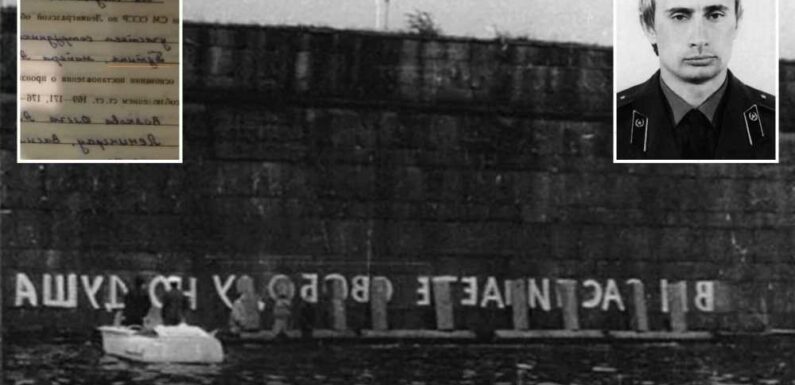
KGB archives reveal Vladimir Putin's dark past as a young officer and his role in sending dissident artists to the gulags in Soviet Russia.
Unearthed files shed new light on the tyrant's sinister early career decades before his meteoric rise to power and murderous war in Ukraine.
And the new evidence chillingly foreshadows the brutal repression of opponents and information during Putin's despotic 22 years in power.
Putin's previously unknown role was discovered in archives relating to raids on the homes of two dissidents in St Petersburg in 1976.
Artist Yuly Rybakov and writer Oleg Volkov were arrested after painting anti-regime graffiti on the giant walls of the Peter and Paul Fortress.
Stretched over 138ft in letters 4ft high, it said: "You may crucify freedom, but the human soul knows no shackles!"
read more on putin
Moment Putin’s feet twitch and spasm in ‘possible sign of Parkinson’s Disease’
How Russian oligarchs are ‘MURDERING each other’ in bloody battle for power
They said the graffiti was a direct response to the KGB after they broke up two earlier rallies, and the location was significant as a former prison for political criminals under the Tsars.
The famous slogan was one of the first instances of protest art to emerge in the tightly controlled USSR and an important symbol of creative resistance against the communist regime at the time.
Files on the case were found in a museum by the historian Konstantin Sholmov, who posted photos online last week.
Putin, then a KGB lieutenant aged 23, was named in the papers as one of the officers who took part in a search of Volkov's home.
Most read in World News
Inside luxury life of Brit ‘super cartel boss’ as map shows drug empire
Tanks roll onto Chinese streets in echo of Tiananmen as Xi crushes protests
Rich Russian 'with spy link' dies in chopper crash after passenger misses trip
Urgent arrest warrant issued for Maddie suspect over ‘THREE rapes & child abuse’
Local politician Boris Vishnevsky said there is now definitive proof Putin was involved in the Soviet crackdown on 70s protest art.
Another KGB lieutenant named in the search protocol went on to work alongside Putin in the 1990s administration of St Petersburg Mayor Anatoly Sobchak.
Volkov was sentenced to seven years in one of the USSR's harsh penal colonies, and Rybakov served six years, charged with anti-Soviet propaganda and hooliganism.
Rybakov later recalled how he and Volkov walked to the city centre Palace Bridge after they finished for a better view of their work.
And he told how KGB goons sent to paint over the slogan were hampered by high water covering the river beach.
Comically, the officers sailed up on rubber boats and propped up coffin lids from a display in the fortress in an attempt to cover the words – which only drew more attention to them.
Exactly forty years later, the same slogan appeared briefly in St Petersburg in 2016 – the work of another artist, Timofey Radya – before being removed by authorities.
Rybakov responded: "Exactly 40 years later (to the day of August 3) the same inscription appears again!
"Well, I can only say – it has not lost its relevance. To new authors – bow."
Rybakov became an MP in the Russian state Duma and is still a prominent human rights campaigner.
He claims Putin also personally participated in another raid on the writer Yulia Voznesenskaya, who was arrested around the same time and charged with anti-Soviet propaganda.
Stasi goon
Other evidence concerning Putin's shady KGB past has come to light in recent years.
Files unearthed in East Germany reveal his stint working with the sinister Stasi secret police between 1985 and 1990.
His spy ID card, locating him in in Dresden, was found in an archive in 2018.
The Stasi was notorious for its close surveillance of the public, recruiting neighbours to spy on each other.
Putin has spoken proudly of his time serving in East Germany, then a Communist state which was effectively run from Moscow.
Vlad joined the KGB's counter-espionage unit in 1975, but was initially not highly rated by his superiors, a biography claimed last year.
However he rose through the ranks to become the chief of the spy agency's successor the FSB in 1997.
He then went from an unknown security chief to the dizzying heights of power in a few short years amid the chaos that followed the break-up of the Soviet Union.
Putin became prime minister of Russia under bungling president President Boris Yeltsin, and stunned political rivals by being elected president himself in 2000.
He has maintained a lethal grip on power ever since, using tactics of intimidation learned in the KGB.
The media has been turned into a propaganda machine, and political opponents have been murdered or jailed on trumped up charges, like arch-critic Alexei Navalny.
But Putin's authority now seems to be waning amid swirling rumours he could be removed or killed in a coup.
Read More on The Sun
I’m a mum of seven – I’ve told my kids they’re getting nothing for Christmas
‘Worst ever’ Christmas market slammed over £9 hot chocolate and no festive stalls
He is feared to be suffering serious illnesses including cancer and Parkinsons after twitching and spasming alarmingly in public appearances.
And his own closest circle are said to be plotting against him after a series of humiliations and catastrophic errors led to a bloodbath in Ukraine.
Source: Read Full Article












